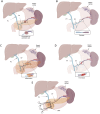Etiologies of Splenic Venous Hypertension: A Review
- PMID: 38974953
- PMCID: PMC11224904
- DOI: 10.14218/JCTH.2024.00054
Etiologies of Splenic Venous Hypertension: A Review
Abstract
Splenic venous hypertension or left-sided portal hypertension is a rare condition caused by an obstruction of the splenic vein. Usually, it presents with upper gastrointestinal bleeding in the absence of liver disease. Etiologies can be classified based on the mechanism of development of splenic vein hypertension: compression, stenosis, inflammation, thrombosis, and surgically decreased splenic venous flow. Diagnosis is established by various imaging modalities and should be suspected in patients with gastric varices in the absence of esophageal varices, splenomegaly, or cirrhosis. The management and prognosis vary depending on the underlying etiology but generally involve reducing splenic venous pressure. The aim of this review was to summarize the etiologies of splenic venous hypertension according to the mechanism of development.
Keywords: Gastric varices; Hematemesis; Left-sided portal hypertension; Sinistral portal hypertension; Splenic vein thrombosis; Splenic venous hypertension; Upper gastrointestinal bleeding.
© 2024 Authors.
Conflict of interest statement
GYW has been an Editor-in-Chief of Journal of Clinical and Translational Hepatology since 2013. The other authors have no conflicts of interest related to this publication.
Figures


References
Publication types
LinkOut - more resources
Full Text Sources
